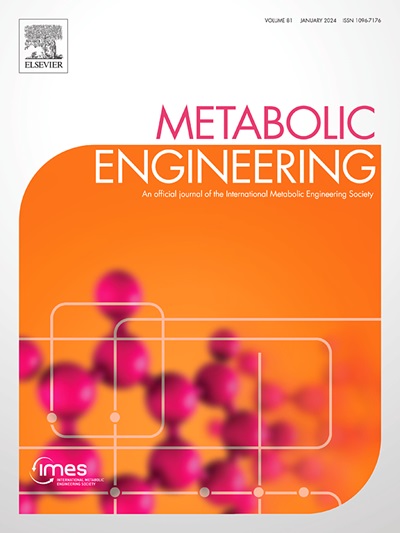Metabolic engineering of yeast for de novo production of kratom monoterpene indole alkaloids
IF 6.8
1区 生物学
Q1 BIOTECHNOLOGY & APPLIED MICROBIOLOGY
引用次数: 0
Abstract
Monoterpene indole alkaloids (MIAs) from Mitragyna speciosa (“kratom”), such as mitragynine and speciogynine, are promising novel scaffolds for opioid receptor ligands for treatment of pain, addiction, and depression. While kratom leaves have been used for centuries in South-East Asia as stimulant and pain management substance, the biosynthetic pathway of these psychoactives have only recently been partially elucidated. Here, we demonstrate the de novo production of mitragynine and speciogynine in Saccharomyces cerevisiae through the reconstruction of a five-step synthetic pathway from common MIA precursor strictosidine comprising fungal tryptamine 4-monooxygenase to bypass an unknown kratom hydroxylase. Upon optimizing cultivation conditions, a titer of ∼290 μg/L kratom MIAs from glucose was achieved. Untargeted metabolomics analysis of lead production strains led to the identification of numerous shunt products derived from the activity of strictosidine synthase (STR) and dihydrocorynantheine synthase (DCS), highlighting them as candidates for enzyme engineering to further improve kratom MIAs production in yeast. Finally, by feeding fluorinated tryptamine and expressing a human tailoring enzyme, we further demonstrate production of fluorinated and hydroxylated mitragynine derivatives with potential applications in drug discovery campaigns. Altogether, this study introduces a yeast cell factory platform for the biomanufacturing of complex natural and new-to-nature kratom MIAs derivatives with therapeutic potential.
从头生产桔梗单萜吲哚生物碱的酵母代谢工程。
来自桔梗(Mitragyna speciosa,"kratom")的单萜吲哚生物碱(MIAs),如mitragynine和speciogynine,是治疗疼痛、成瘾和抑郁症的阿片受体配体的新型支架。几个世纪以来,东南亚地区一直使用桔梗叶作为兴奋剂和止痛药,但这些精神活性物质的生物合成途径直到最近才被部分阐明。在这里,我们展示了在酿酒酵母(Saccharomyces cerevisiae)中从常见的 MIA 前体严格苷(Strictosidine)通过真菌色胺 4-单加氧酶绕过未知的桔梗羟化酶,重建五步合成途径,从而从头生产出丝氨酸(mitragynine)和桔梗碱(speciogynine)。通过优化培养条件,从葡萄糖中获得了滴度为∼290 μg/L 的桔梗 MIAs。通过对主要生产菌株进行非靶向代谢组学分析,确定了许多来自严格苷合成酶(STR)和二氢紫堇碱合成酶(DCS)活性的分流产物,突出表明它们是酶工程的候选物,可进一步提高酵母中桔梗 MIAs 的产量。最后,通过饲喂氟化色胺和表达人类定制酶,我们进一步证明了氟化和羟化丝氨酸衍生物的生产,这些衍生物在药物发现活动中具有潜在的应用价值。总之,本研究介绍了一种酵母细胞工厂平台,用于生物制造具有治疗潜力的复杂天然和新天然桔梗 MIAs 衍生物。
本文章由计算机程序翻译,如有差异,请以英文原文为准。
求助全文
约1分钟内获得全文
求助全文
来源期刊

Metabolic engineering
工程技术-生物工程与应用微生物
CiteScore
15.60
自引率
6.00%
发文量
140
审稿时长
44 days
期刊介绍:
Metabolic Engineering (MBE) is a journal that focuses on publishing original research papers on the directed modulation of metabolic pathways for metabolite overproduction or the enhancement of cellular properties. It welcomes papers that describe the engineering of native pathways and the synthesis of heterologous pathways to convert microorganisms into microbial cell factories. The journal covers experimental, computational, and modeling approaches for understanding metabolic pathways and manipulating them through genetic, media, or environmental means. Effective exploration of metabolic pathways necessitates the use of molecular biology and biochemistry methods, as well as engineering techniques for modeling and data analysis. MBE serves as a platform for interdisciplinary research in fields such as biochemistry, molecular biology, applied microbiology, cellular physiology, cellular nutrition in health and disease, and biochemical engineering. The journal publishes various types of papers, including original research papers and review papers. It is indexed and abstracted in databases such as Scopus, Embase, EMBiology, Current Contents - Life Sciences and Clinical Medicine, Science Citation Index, PubMed/Medline, CAS and Biotechnology Citation Index.
 求助内容:
求助内容: 应助结果提醒方式:
应助结果提醒方式:


